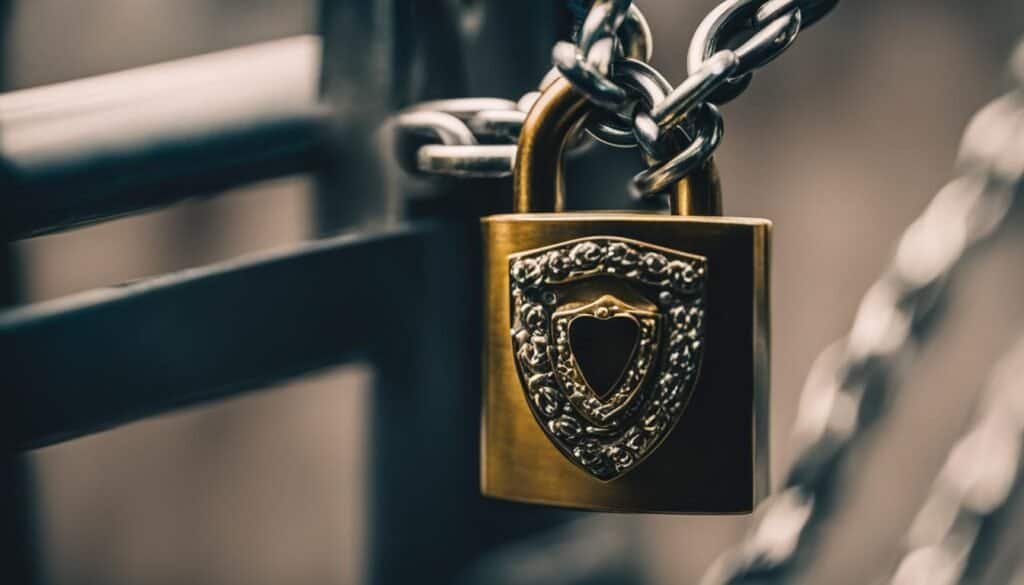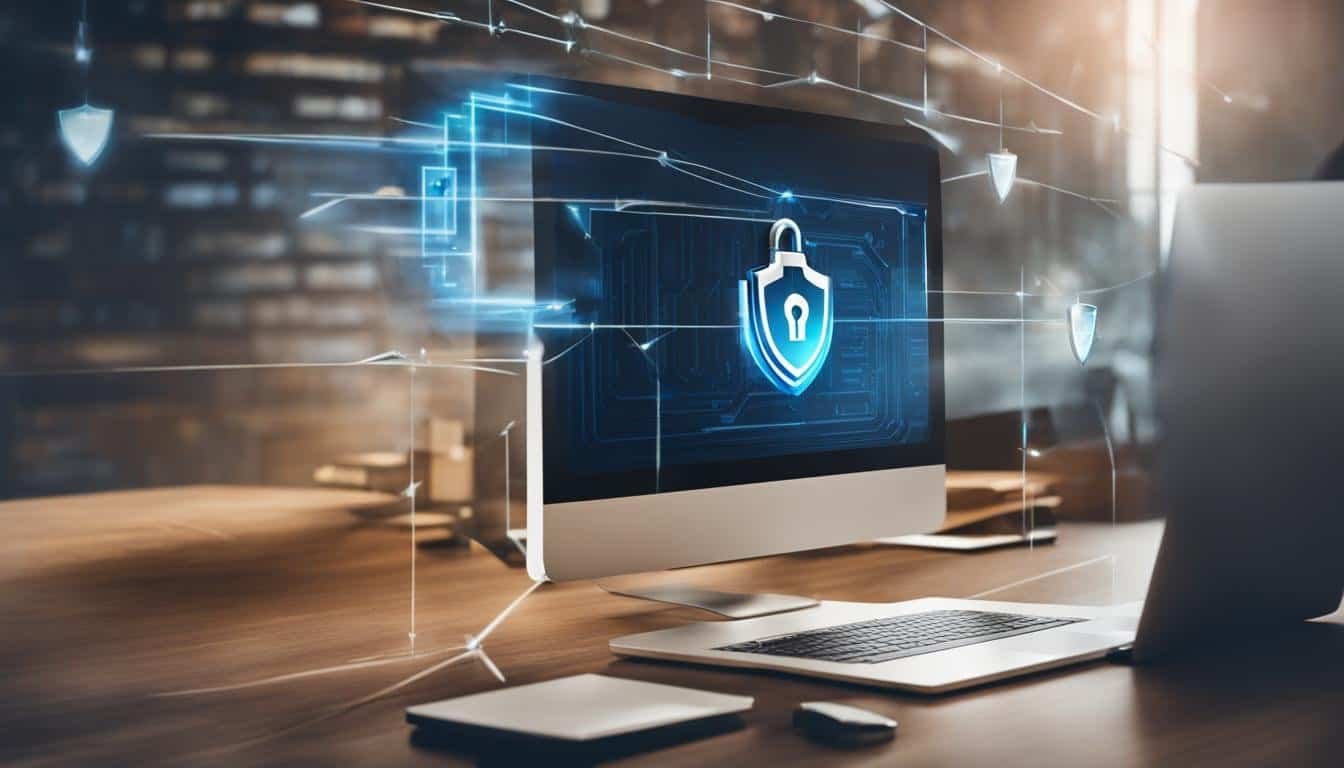If you suspect that your email or social media account has been hacked, it’s important to take immediate action to recover your account and protect your personal information. Being a victim of a cybersecurity incident can be distressing, but we are here to help you navigate through the recovery process.
Signs that your account may have been hacked include being unable to log in, receiving notifications of unauthorized changes, or your friends and family reporting suspicious messages or emails. Acting swiftly is crucial to regain control of your account and minimize the damage caused by the hack.
In this article, we will guide you through the steps you should take after being hacked, including updating your computer security software, following your provider’s account recovery instructions, changing your password, enabling two-factor authentication, and checking for any signs of unauthorized access or activity.
Recovering from a hack can be overwhelming, but with our expert guidance, you’ll be able to secure your compromised accounts and prevent future attacks. So, let’s get started!
Key Takeaways:
- Act immediately if you suspect your account has been hacked to minimize the damage.
- Update your computer security software and run a scan to detect any malware.
- Follow your provider’s account recovery instructions to regain control of your hacked account.
- Change your password, sign out of all devices, and enable two-factor authentication for added security.
- Check for any signs of unauthorized access or activity after recovering your account.
Signs That Someone Hacked Your Account
When it comes to cybersecurity, it’s important to be aware of the signs that indicate your account may have been hacked. By recognizing these signs early on, you can take swift action to protect your account and personal information. Here are some common signs of a hacked account:
- Unable to log in: If you find yourself unable to log in to your account, even with the correct credentials, it could be a sign that someone has gained unauthorized access.
- Notifications of unauthorized changes: If you receive notifications of changes to your account that you did not make, such as changes to your password or username, it’s likely that your account has been compromised.
- Suspicious activity: Keep an eye out for any unusual activity within your account, such as unfamiliar login activity from unrecognized devices or locations.
- Reports of suspicious messages: If your contacts report receiving suspicious emails or messages that you did not send, it’s a strong indication that your account has been hacked.
These signs suggest that someone has gained unauthorized access to your account and may be attempting to steal your personal information or use your account for malicious purposes. It’s important to take immediate action if you notice any of these signs to protect your account and prevent further harm.
“Recognizing the signs of a hacked account is crucial to taking swift action and protecting your account.”
Examples of Common Phishing Attempts:
| Phishing Attempt | How to Spot It |
|---|---|
| Fake login page | Check the URL for any discrepancies or look for misspellings in the website address. |
| Urgent message | Beware of urgent messages that create a sense of panic or pressure you to take immediate action. |
| Unexpected attachments | Be cautious of unexpected email attachments, especially from unknown senders. |
| Phishing emails disguised as official communication | Pay close attention to email addresses, grammar, and spelling errors in the email. |
Phishing attempts are a common method used by hackers to trick individuals into revealing their login credentials or personal information. By being aware of these common phishing techniques and staying vigilant, you can protect yourself from falling victim to such attacks.
Remember, the key to protecting your account is being proactive and staying informed. By recognizing the signs of a hacked account, such as unauthorized changes, suspicious activity, and phishing attempts, you can take immediate action to secure your account and prevent further damage.
Steps to Recover Your Hacked Account

If you suspect that your email or social media account has been hacked, it is important to follow the account recovery instructions provided by your service provider. For email account recovery, you can click on the recovery links provided by popular email providers such as Google, Yahoo, and Microsoft. Similarly, social media platforms like Facebook, Instagram, Twitter, and LinkedIn have account recovery processes in place to help you regain control. These processes typically involve verifying your identity through various methods, such as answering security questions or providing additional contact information. By following the provided instructions, you can regain control of your hacked account and take steps to secure it.
If you are recovering your email account, you may need to access an alternative email address or phone number associated with your account to verify your identity. Make sure to have this information ready before starting the recovery process. Once you have regained access, it is important to change your password immediately to a strong and unique one. Avoid reusing old passwords or using easily guessable ones. This will help protect your account from future hacking attempts.
For social media account recovery, you may need to go through similar verification steps. This can include confirming your identity through email, phone number, or personal information. Once you have successfully recovered your account, it is essential to review your account settings and enable any security features available, such as two-factor authentication. This adds an extra layer of protection by requiring a verification code in addition to your password when logging in.
| Account Recovery Instructions | Email Account Recovery | Social Media Account Recovery | Password Reset |
|---|---|---|---|
| 1 | Access recovery links provided by your email provider | Follow the account recovery process of the respective social media platform | Change your password to a strong and unique one |
| 2 | Verify your identity through security questions or additional contact information | Confirm your identity via email, phone number, or personal information | Avoid reusing old passwords or easily guessable ones |
| 3 | Change your password immediately after regaining access | Review your account settings and enable two-factor authentication |
Recovering a hacked account can be a stressful experience, but by following the account recovery instructions provided by your service provider, you can regain control and secure your account. Remember to choose strong and unique passwords, enable two-factor authentication, and regularly update your account recovery information to better protect yourself from future hacking attempts.
Securing Your Account After Recovery

Once you have successfully recovered your hacked account, it is essential to take proactive steps to enhance its security and prevent future attacks. By implementing the following measures, you can significantly reduce the risk of your account being compromised again:
- Create a Strong Password: Choose a password that is unique, complex, and difficult to guess. Include a combination of uppercase and lowercase letters, numbers, and special characters. Avoid using common phrases, names, or easily guessable information.
- Enable Two-Factor Authentication (2FA): Two-factor authentication adds an extra layer of security to your account by requiring a second verification step, usually a unique code sent to your registered mobile device. This ensures that even if someone obtains your password, they won’t be able to access your account without the additional code.
- Review Account Recovery Information: Regularly check and update your account recovery information, including email addresses and phone numbers. Ensure that the listed information is accurate and accessible so that you can recover your account easily if needed.
By following these practices, you can strengthen the security of your account and reduce the chances of future unauthorized access. It is crucial to remain vigilant and stay informed about emerging security threats to protect your online presence effectively.
Additional Tips for Account Security:
In addition to the above measures, here are some extra tips to further enhance the security of your account:
- Regularly Update Security Software: Keep your computer security software, such as antivirus and anti-malware programs, up to date to protect against the latest threats.
- Be Wary of Suspicious Emails and Links: Avoid clicking on links or downloading attachments from unfamiliar or suspicious sources. These can be phishing attempts designed to steal your account information.
- Monitor Account Activity: Regularly review your account activity for any signs of unauthorized access or suspicious activity. Report any anomalies to your service provider immediately.
Implementing these security measures, along with practicing good online hygiene, can significantly reduce the risk of your account being hacked and help safeguard your personal information.
Checking for Signs of Unauthorized Access
Once you have regained control of your hacked account, it is crucial to check for any signs that the hacker may have had access to your account. By identifying these signs, you can take the necessary steps to further secure your account and prevent future unauthorized access.
Email Forwarding Rules
One of the first things you should check for is whether the hacker has set up any email forwarding rules without your knowledge. These rules allow the hacker to receive copies of your incoming emails, potentially giving them access to sensitive information. To check for email forwarding rules, go to your email settings and look for any rules that redirect your messages to unfamiliar email addresses. If you find any suspicious rules, delete them immediately to stop the unauthorized access.
Suspicious Sent Emails
In addition to checking for forwarding rules, you should also review your sent folder for any emails that the hacker may have sent from your account. Look for any unfamiliar or suspicious email addresses in the recipient field, as well as any messages that you did not send yourself. If you come across any suspicious sent emails, notify your contacts about the hack and advise them to be cautious of any messages they may have received from your account during the unauthorized access.
Hacked Social Media Messages
For social media accounts, it’s important to check for any messages or posts that the hacker may have made from your account. Look for any unusual activity, such as messages sent to people you don’t know or posts that you did not create. If you find any suspicious social media messages or activities, delete them and inform your followers and connections about the hack. By doing so, you can prevent any further damage or spreading of malicious content.
| Signs of Unauthorized Access | Action to Take |
|---|---|
| Email Forwarding Rules | Delete any unfamiliar email forwarding rules found in your email settings. |
| Suspicious Sent Emails | Notify your contacts about the hack and advise them to be cautious of any messages received from your account during the unauthorized access. |
| Hacked Social Media Messages | Delete any suspicious social media messages or posts and inform your followers and connections about the hack. |
By checking for signs of unauthorized access, such as email forwarding rules, suspicious sent emails, and hacked social media messages, you can strengthen the security of your account and minimize the risk of future hacks. Remember to regularly review and monitor your account activity to ensure that it remains secure and protected.
Conclusion
Recovering from a hack can be a distressing experience, but we are here to guide you through the necessary steps to regain control of your compromised accounts and prevent future attacks. By promptly recognizing the signs of a hacked account, taking swift action, and following the appropriate recovery instructions, you can minimize the damage and protect your personal information.
Once you have recovered your hacked account, it is crucial to focus on securing it. Take the time to change your password to a strong and unique one that is difficult for hackers to guess. Additionally, enable two-factor authentication (2FA) to add an extra layer of security by requiring a verification code in addition to your password. These simple steps can significantly enhance the security of your accounts.
Remember to proactively check for any signs of unauthorized access after regaining control. Review your email forwarding rules, sent emails, and deleted items for any suspicious activity. For social media accounts, check for any unauthorized posts, messages, or connections. By identifying and addressing these signs, you can further protect your accounts from future attacks.
In conclusion, recovering from a hack requires a combination of immediate action, security measures, and ongoing vigilance. By following our guidance and staying informed about the latest cybersecurity best practices, you can safeguard your online presence and minimize the risk of future hacks. Your security is our priority, and we are here to help you every step of the way.
What Steps Can I Take to Protect Myself from Being Hacked?
In order to safeguard yourself from potential cyber threats, it is crucial to take certain precautions. First, ensure your devices, such as computers and smartphones, have up-to-date security software installed. Secondly, create strong, unique passwords for all your accounts. Additionally, be cautious of suspicious emails and avoid clicking on unknown links. Regularly backup your data and consider encrypting sensitive information. These simple yet significant measures can serve as your hacking journey starting points, fortifying your defenses against potential hackers.
FAQ
What are the signs that someone hacked my account?
Signs of a hacked account may include being unable to log in, receiving notifications of unauthorized changes, or your friends and family reporting suspicious messages or emails.
How can I recover my hacked account?
To recover your hacked account, it is crucial to update your computer security software, run a scan, and follow your provider’s account recovery instructions.
What should I do to secure my account after recovering it?
After regaining access, you should change your password, sign out of all devices, enable two-factor authentication (2FA), and check for any signs of unauthorized access or activity.
How can I check for signs of unauthorized access to my account?
For email accounts, check if there are any email forwarding rules set up, review your sent and deleted folders for suspicious activity. For social media accounts, look for any messages or posts that the hacker may have posted or sent from your account, as well as any new friends or connections that you do not recognize.
What should I do if my account has been hacked?
If you suspect that your email or social media account has been hacked, it is important to follow the account recovery instructions provided by your service provider.
How can I prevent future hacks and keep my account secure?
To prevent future hacks, it is important to use a strong and unique password, enable two-factor authentication (2FA), and regularly update your account recovery information. Educating yourself about cybersecurity best practices can also help protect your account from future attacks.




0 Comments